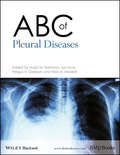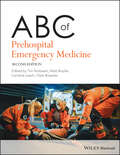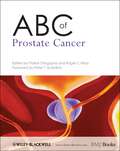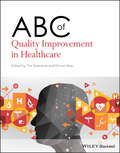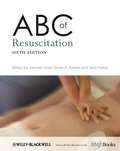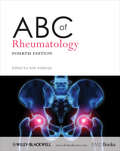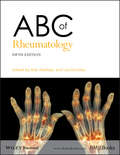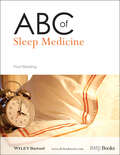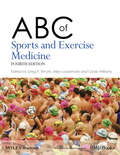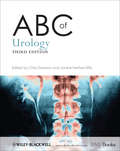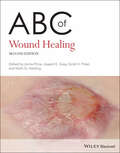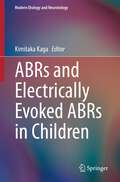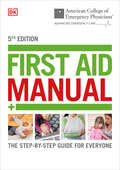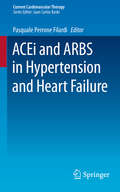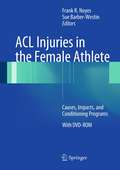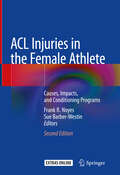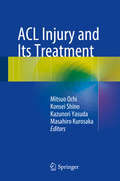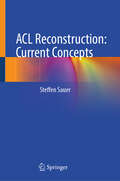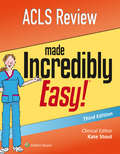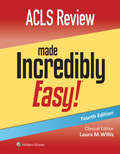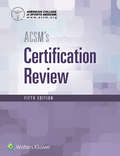- Table View
- List View
ABC of Pleural Diseases (ABC Series)
by Najib M. Rahman Ian Hunt Fergus V. Gleeson Nick A. MaskellPleural diseases are frequently managed in primary care, but specialist knowledge is required to understand the full variety of presentations and available treatments in this rapidly developing field. ABC of Pleural Diseases is a brand new addition to the ABC Series which takes a unique approach to these conditions by dealing with them as a related group as well as in their individual manifestations. The book provides a unique and comprehensive overview of pleural disease, beginning with the anatomy and physiology of the pleura. It then covers a wide range of specific conditions in greater detail, including pneumothorax, pleural effusions, pleural infections, as well as chapters on radiology and pathology. Full coverage is given of mesothelioma, the most common pleural cancer. Written by a team of specialists, this reference guide to pleural diseases is a practical guide for General Practitioners, Junior Doctors, Specialist Nurses, Radiologists and all Healthcare Professionals working within chest medicine.
ABC of Prehospital Emergency Medicine
by Tim Nutbeam Matthew BoylanPrehospital Emergency Medicine (PHEM) is a new and evolving field within Prehospital Care and involves the delivery of safe prehospital critical care to seriously ill or injured patients, and safe transfer to or between hospitals. It covers a broad range of medical and traumatic conditions, interventions, clinical providers and physical environments.ABC of Prehospital Emergency Medicine is the first text to provide a comprehensive overview of this field and with an international team of expert authors is essential reading to anyone involved in the delivery of Prehospital Emergency Medicine and Prehospital Care.
ABC of Prehospital Emergency Medicine (ABC Series)
by Tim Nutbeam Caroline Leech Clare Bosanko Matt BoylanIn the newly revised second edition of ABC of Prehospital Emergency Medicine, a team of experienced prehospital practitioners deliver a comprehensive up-to-date guide to the rapidly evolving field of prehospital emergency medicine. The book includes evidence-based practice and expert opinion to meet the needs of the PHEM training curriculum covering operational, clinical and system considerations. An international team of expert editors and contributors have also provided readers with: A thorough introduction to prehospital emergency medicine, including activation and deployment, personal protective equipment, and scene safety and assessment Comprehensive exploration of the primary survey, airway, breathing, and circulation assessments Practical discussions of prehospital anesthesia, analgesia, sedation, monitoring and ultrasound The prehospital management of medical, trauma and psychiatric emergencies How to care for special groups, including the elderly, obstetric, pediatric, and bariatric patients Considerations in mass casualty and chemical, biological, radiation, and nuclear incidents. ABC of Prehospital Emergency Medicine is essential reading for paramedics, doctors, nurses and other prehospital practitioners. The text is ideal for those undertaking subspecialty PHEM training, those studying for postgraduate prehospital degree modules, or practitioners undertaking PHEM exams.
ABC of Prostate Cancer
by Prokar Dasgupta Roger S. KirbyProstate cancer is the most common cancer in men in the UK and US and the second most common worldwide.The ABC of Prostate Cancer provides fully illustrated guidance on the treatment and management of prostate cancer. It covers the biology, anatomy, and pathology of prostate cancer, screening, and active surveillance and monitoring. It presents an assessment of treatment options including prostatectomy, bracytherapy, chemotherapy and immunotherapy, along with modern diagnostic tests and an overview of new approaches to prostate cancer.With an international author team, the ABC of Prostate Cancer is ideal for general practitioners, family physicians, specialist nurses, junior doctors, medical students and others working with prostate cancer patients and their families.
ABC of Quality Improvement in Healthcare (ABC Series)
by Tim Swanwick Emma VauxQuality improvement (QI) is embedded in the fabric of successful healthcare organisations across the world, with healthcare professionals increasingly expected to develop and lead improvement as a core part of their clinical responsibilities. As a result, QI is rapidly becoming a feature of the education and training programmes of all healthcare professionals. Written and edited by some of the leading clinicians and managers in the field, ABC of Quality Improvement is designed for clinicians new to the discipline, as well as experienced leaders of change and improvement. Providing comprehensive coverage and clear, succinct descriptions of the major tools, techniques and approaches, this new addition to the ABC series demystifies quality improvement and develops a broader understanding of what constitutes quality in healthcare. With practical examples of improvement interventions and the common pitfalls that can befall them, this book will support and enable readers to manage change projects within their own organisations. Relevant to doctors, dentists, nurses, health service managers and support staff, medical students and doctors in training, their tutors and trainers, and other healthcare professionals at various levels, ABC of Quality Improvement will give readers the confidence to embark on their own improvement projects, whoever, and wherever they may be.
ABC of Resuscitation
by Gavin D. Perkins Jerry Nolan Jasmeet SoarABC of Resuscitation is a practical, illustrated guide to the latest resuscitation advice for the non-specialist and provides the core knowledge on the treatment of cardiopulmonary arrest.This edition provides a guide to the European Resuscitation Council Guidelines for Resuscitation 2010 and the Resuscitation Council (UK) 2010 Resuscitation Guidelines.It Includes:the causes and prevention of cardiac arrestbasic and advanced life support for adults, children and newbornsresuscitation in a range of contexts (in-hospital and out-of-hospital, including drowning, pregnancy, sport and trauma)important aspects of implementation of guidelines including human factors and education ABC of Resuscitation, 6th Edition is ideal for all healthcare professionals including junior doctors, medical students, general practitioners, paramedics and nurses. It is also useful for pre-hospital care practitioners, emergency medicine trainees, resuscitation officers and all those who teach resuscitation.
ABC of Rheumatology
by Ade AdebajoMusculoskeletal diseases are the most widespread chronic illness in the UK and one of the top 3 reasons why the over 45s visit their GP. The ABC of Rheumatology is a practical, introductory guide to the diagnosis, management and treatment of rheumatology and rheumatic diseases for the non-specialist. Providing detailed overviews of all major areas of rheumatology this fully revised fourth edition includes updated information on new treatments, therapies, evidence and guidelines.An informative and practical source of knowledge, with highly illustrated chapters including boxed summaries, links to further information, reading and resources, this well established ABC title is an accessible reference for all primary care health professionals, GPs, junior doctors, medical students and nurses.
ABC of Rheumatology (ABC Series #189)
by Ade Adebajo Lisa DunkleyABC of Rheumatology continues to be a practical and informative guide to the assessment, treatment and management of common rheumatic and musculoskeletal conditions within primary care. Fully updated to reflect developments in this fast growing field, the fifth edition covers overviews of all key areas of rheumatology, and includes new chapters on radiology and immunology, as well as expanded coverage on metabolic bone disease, chronic widespread pain, and complex regional pain syndrome. Featuring highly illustrated chapters, boxed summaries and links to further resources, ABC of Rheumatology is an accessible reference for all primary care health professional, general practitioners, family physicians, junior doctors, medical students and nurses.
ABC of Sleep Medicine
by Paul ReadingA practical illustrated guide to sleep disorders which will give health professionals confidence in this complex area of diagnosis and management.It explains the differences between normal and abnormal sleep, and looks in depth at individual disorders such as sleep apnoea, insomnia, narcolepsy, restless legs syndrome and the parasomnias, as well as sleep disorders as a comorbidity of neurodegenerative and psychiatric disease. Common sleep disorders in children are addressed in detail before concluding with an overview of pharmacological treatments and how commonly used drugs might affect sleep.
ABC of Sports and Exercise Medicine
by Clyde Williams Gregory Whyte Mike LoosemoreThe ABC of Sports and Exercise Medicine provides general practitioners with a comprehensive overview of the field of sports medicine. This highly illustrated and thoroughly revised and updated new edition:* Reflects new developments and current practice* Includes new chapters on medical care at sporting events, environmental factors of sports and exercise, benefits of exercise in health and disease, nutrition and ergogenic supplements, and the use of drugs in sport* Covers the benefits of exercise among special populations such as the disabled, obese, pregnant, children and the elderlyCovering the latest topics and including case studies of common sports and exercise medicine conditions, the ABC of Sports and Exercise Medicine is an essential practical guide for general practitioners, family physicians, junior doctors, medical students, physiotherapists, and all health professionals dealing with the treatment and prevention of sports-related injuries.
ABC of Stroke
by Jonathan Mant Marion F. WalkerStroke is the most common cause of adult disability and is of increasing importance within ageing populations.This brand new title in the ABC series covers the entire patient journey, from prevention through to long-term support. It includes primary prevention and management of risk factors for stroke and secondary prevention including pharmaceutical, lifestyle and surgical intervention. The general principles of stroke rehabilitation are also addressed as well as mobility, communication and psychological problems, as is stroke in younger people. It also covers long-term support for stroke survivors and their carers.This is an invaluable and practical guide to all aspects of stroke for both health care professionals and lay audiences. It is of particular relevance to general practitioners, junior doctors, nurses and therapists working with stroke patients and their carers, and to people with stroke and their families.
ABC of Transfer and Retrieval Medicine
by Adam Low Jonathan HulmeABC of Transfer and Retrieval Medicine provides the key information required to help health care professionals involved in the movement of critically ill patients to do so safely, correctly and with confidence. Beginning with the practical and clinical considerations to be taken into account during patient transfer and an overview of transfer equipment, it then addresses pharmacological aspects of patient transfer, the roles and responsibilities of the transfer team, and the requirements of neonatal, paediatric and specialist transfers. Mapped against the syllabus for the Diploma of Retrieval and Transfer Medicine (Royal College of Surgeons of Edinburgh), it has been developed as a core resource for the diploma whilst providing an invaluable resource for any healthcare professional involved in the transfer of critically ill patients including anaesthetists, intensivists, nurses from ICU/ED and paramedics. It also includes frameworks for radiology and arterial blood gas interpretation, guidance on patient triage, transfer checklists and equipment checklists, and a summary of the relevant national guidelines. From a multidisciplinary international author team, this new addition to the ABC series is a useful resource for all health care professionals involved in the transfer of patients. It is relevant to anaesthetists, intensivists, paramedics, critical care and emergency department nursing staff who are required to take part in intra and inter hospital transfers.
ABC of Urology
by Chris Dawson Janine NethercliffeThe ABC of Urology provides a comprehensive review of current practice in urology and is a structured and practical guide to the diagnosis, treatment and management of the most common urological conditions. This new third edition has been fully revised and expanded with additional chapters and improved coverage of renal and testis cancer, management of haematuria, laparoscopy, trauma and new urological advances. Prostate, bladder, renal and penile cancers are also covered in detail and new techniques and procedures for safer and effective treatment options are featured.The ABC of Urology is the ideal reference for general practitioners and general practitioner trainees, junior doctors and practice nurses, medical students and all primary health care professionals working to provide the best possible care for patients with urological conditions.
ABC of Wound Healing (ABC Series #262)
by Annie PriceABC of Wound Healing ABC of Wound Healing, Second Edition ABC of Wound Healing is a practical, highly illustrated guide to assessment, diagnosis and management of all common types of acute and chronic wounds. This concise yet comprehensive reference covers all essential aspects of wound healing care, including epidemiology, pathophysiology, assessment, treatment, long-term management, and prevention This revised second edition contains several new chapters on lymphoedema, nutrition, skin care, continence, and scarring. Updated and expanded chapters cover a wider range of devices and therapies, and discuss additional factors that impact wound healing processes, offering new clinical photographs as a visual guide. Applying a multidisciplinary approach to the provision of wound care, ABC of Wound Healing: Covers common wounds including traumatic wounds, surgical wounds, diabetic foot ulcers, pressure injuries, and venous and arterial leg ulcers Emphasises the importance of reaching a diagnosis, the fundamental step in managing any wound Provides up-to-date information on physical, chemical, biological and emerging therapies for patients with various types of wounds Contains hundreds of full-colour illustrations and clinical photographs of wounds and treatments ABC of Wound Healing, Second Edition, remains a must-have guide for junior doctors, specialist registrars in medicine and surgery, specialist nurses, general practitioners and medical students.
ABRs and Electrically Evoked ABRs in Children (Modern Otology and Neurotology)
by Kimitaka KagaFor more than 40 years, Auditory Brainstem Responses (ABRs) have been used as a diagnostic tool for hearing disorders and brainstem disorders in the pediatric audiology and neurotology and child neurology. While there are many publications in this field, this new volume will review hearing problems and neurological disorders in babies, infants and children, and discuss important new advances such as ABR figure and threshold changes with infant development. The book will also cover auditory neuropathy, its numerous and new sub-classifications. Readers will be thoroughly briefed on all the new perspectives in interpreting data. Researchers and clinicians will find the text to be a valuable tool in the correct diagnosis of hearing problems and neurological diseases among babies and infants.
ACADEMIA: Surgeon in training, Garven Wilsonhulme, fang-and-claw competition for glory
by Carl DouglassAcademia: The Law of the Jungle by Author Carl Douglass, neurosurgeon turned author who writes with such gripping realism, is a novel of a driven man who finally gets to be a surgeon in training and then an academic neurosurgeon on his way to the top of his profession. He watched the fall from glory of his mentor, and came face to face with his greatest opponents in the fang-and-claw competition of a merciless competition at the heights of prestige.
ACEP First Aid Manual 5th Edition: The Step-by-Step Guide for Everyone
by DKA possible life-saving reference to keep around the house or in the car, DK's First Aid Manual looks at more than 100 different conditions, from splinters and sprained ankles to strokes and unconsciousness, and shows exactly what to do with step-by-step photographic sequences. Every condition is clearly explained, outlining causes, symptoms, and signs, and action plans. The updated design makes the instructions easier to follow, whether you need information on emergency first aid, first aid for babies and children, or tips on resuscitation. This ACEP First Aid Manual is an invaluable resource to keep you and your loved ones safe and healthy.
ACEi and ARBS in Hypertension and Heart Failure (Current Cardiovascular Therapy #5)
by Pasquale Perrone FilardiThe renin angiotensin system is implicated in the progression of atherosclerotic disease as well as of left ventricular dysfunction. Angiotensin converting enzyme inhibitors and AT1 receptor antagonists have been proven to reduce morbidity and mortality in patients with left ventricular dysfunction or in those at high cardiovascular risk with preserved ventricular function. This book is intended to summarize evidences and provide a rationale for the appropriate use of RAS antagonists in cardiovascular diseases. It will be presented as highly practical information on this topic, written in a quick-access, no-nonsense format. The emphasis will be on a just-the-facts clinical approach, heavy on tabular material, light on dense prose. The involvement of the ISCP will ensure that the best quality contributors will be involved and establish a consistent approach to each topic in the series and this title is no exception. It will contain practical illustrations and is designed to improve understand and practical usage of cardiovascular drugs in specific clinical areas.
ACL Injuries in the Female Athlete: Causes, Impacts, and Conditioning Programs
by Frank R. Noyes Sue Barber-WestinNearly a million anterior cruciate ligament (ACL) injuries occur each year worldwide, causing long-term problems in the knee joint. This textbook examines the short- and long-term impacts of ACL injuries on the basis of hundreds of published studies. Risk factors for such injuries are explored using data from hypothesis-driven investigations, and possible causes of the higher risk of noncontact ACL injuries in female athletes are analyzed. Neuromuscular training programs shown to reduce the rate of these injuries in female athletes are described in step-by-step detail with the aid of numerous color photographs and video demonstrations. In addition, detailed descriptions are provided for rehabilitation programs to be used after ACL reconstruction in order to reduce the risk of a future injury. The book will be of value to orthopedic surgeons, physical therapists, athletic trainers, sports medicine primary care physicians, and strength and conditioning specialists.
ACL Injuries in the Female Athlete: Causes, Impacts, and Conditioning Programs
by Frank R. Noyes Sue Barber-WestinThis successful book, now in a revised and updated second edition, reviews all aspects of anterior cruciate ligament (ACL) injuries in female athletes, with the focus on complete, noncontact ACL injuries. The opening section discusses anatomy and biomechanics and explains the short- and long-term impacts of complete ACL ruptures, including long-term muscle dysfunction and joint arthritis. Risk factors and possible causes of the higher noncontact ACL injury rates in female athletes compared with male athletes are then discussed in depth. Detailed attention is devoted to neuromuscular training programs and their effectiveness in reducing noncontact ACL injury rates in female athletes, as well as to sports-specific ACL injury prevention and conditioning programs of proven value. Rehabilitation programs after ACL injury and reconstruction that reduce the risk of a future injury are explored, and the concluding section looks at worldwide implementation of neuromuscular ACL injury prevention training and future research directions. The book will be of value to orthopedic surgeons, physical therapists, athletic trainers, sports medicine primary care physicians, and strength and conditioning specialists.
ACL Injury and Its Treatment
by Mitsuo Ochi Konsei Shino Kazunori Yasuda Masahiro KurosakaThis volume presents detailed information on surgically relevant anatomy and histology of the anterior cruciate ligament (ACL), biomechanics, diagnostics, and ACL reconstruction. In light of the growing body of evidence demonstrating the advantages of anatomic ACL reconstruction over traditional methods, there are also discussions of single anteromedial bundle reconstruction and anatomic ACL reconstruction with abundant descriptions of experimental and clinical studies. In addition, particular attention is given not only to techniques such as ACL augmentation, bone-patella tendon-bone reconstruction and computer-assisted navigation, but it also presents expert analysis of revision of ACL reconstruction, complications, and the future perspectives of ACL reconstruction. Edited by authoritative orthopedic surgeon from the Japanese Orthopaedic Society of Knee, Arthroscopy and Sports Medicine (JOSKAS), this book provides up-to-date information for orthopedic surgeons and physical therapists specializing in the ACL. The research evidence will broaden readers' understanding and enable them to optimize outcomes for patients. As ACL rupture is a common injury especially for high-level athletes, it will also attract sports trainers and team physicians who are interested in a recent update on this field.
ACL Reconstruction: Current Concepts
by Steffen SauerThis book covers the main principles of ACL reconstructive surgery, both surgical techniques and treatment algorithms, while additionally looking at unsolved questions and conflicting aspects. Based on the best available evidence, current concepts of ACL reconstruction are given and add to the ongoing endeavour for improvement of ACL reconstruction outcomes.
ACLS Review Made Incredibly Easy (Incredibly Easy! Series®)
by Lww Kate StoutCLS Review Made Incredibly Easy!® gives you the confidence you need to pass the ACLS certification exam as well as the knowledge and skills needed to perform advanced cardiac life support. Packed with easy-to-remember definitions and step-by-step directions on the latest treatment algorithms, this enjoyable review text tackles required ACLS course and exam content. It is also the perfect on-the-spot clinical reference—for nurses, students, and all healthcare professionals. Be expertly guided through the latest ACLS training and exam preparation with: NEW and updated content in quick-read, bulleted format, based on current American Heart Association guidelines NEW and updated cardiovascular pharmacology content NEW and updated interventions Explains ACLS course and exam components and requirements Proven study strategies, end-of-chapter quick quizzes, and an end-of-book practice test Explanations of complex concepts—easy-to-retain guidance on how to recognize and treat cardiac arrhythmias, including: Classifications of interventions, including basic life support skills, adult cardiac arrest algorithm, and defibrillation Step-by-step how-tos for current treatment algorithms Managing specific rhythms—hypovolemia, hypoxia, acidosis, hypothermia, cardiac tamponade, tension pneumothorax, pulmonary coronary thrombosis, and more Dozens of colorful diagrams and illustrations outline the core concepts and skills needed for ACLS certification, including: CPR – when and how to use it Devices and procedures skills – safe ventilation techniques, including endotracheal intubation and supraglottic devices, as well as defibrillators, pacemakers, and more Early management – managing the first 30 minutes of cardiac emergencies Emergency conditions – which cardiac rhythms may require ACLS treatment IV and invasive techniques – such as peripheral and central IV line insertion Pharmacology – knowing the action, indication, dosages, and precautions for the major drugs used during ACLS Special features that include: Just the facts – quick summary of each chapter’s content o “Nurse Joy” and “Nurse Jake” – expert insights on interventions and problem-solving Quick quiz – multiple-choice questions after each chapter to help you retain knowledge o Now I get it! – real-life patient scenarios illustrating correct ACLS interventions o What to look for – tips on identifying and interpreting arrhythmias. About the Clinical Editor Kate Stout, RN, MSN, is a Critical Care Charge RN at Southern Hills Hospital in Las Vegas, Nevada.
ACLS Review Made Incredibly Easy (Incredibly Easy! Series®)
by Laura WillisACLS Review Made Incredibly Easy!, 4th Edition is packed with easy-to-remember definitions and step-by-step directions on the latest algorithms giving you the confidence you need to pass the ACLS certification exam as well as the knowledge and skills needed to perform advanced cardiac life support.
ACSM's Certification Review
by American College of Sports MedicineWith ACSM's Certification Review as your guide, you can be ready to successfully pass the exam to become a Certified Personal Trainer (CPT), Certified Exercise Physiologist (EP-C), or Certified Clinical Exercise Physiologist (CEP). As a review tool, this text will help you identify your strengths and weaknesses and then eliminate those areas of weakness with further study. Most importantly, this text will help you advance your career in fitness and exercise. Now aligned with the tenth edition of the ACSM’s Guidelines for Exercise Testing and Prescription, this text is reflective of the key changes and the only print resource for the current ACSM certification exams. ACSM's Certification Review is organized into three parts by certification level.
